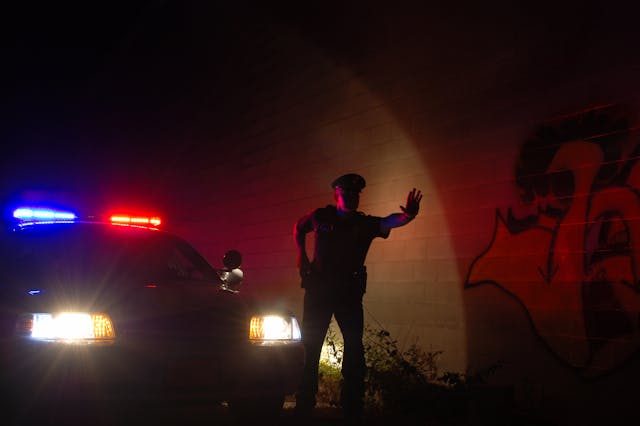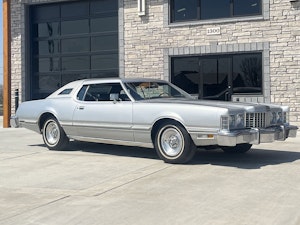Media | Articles
You always remember your first police chase
It’s been years, but I remember my first high-speed chase. I suspect most police officers do. This was the early 1990s, and I was working for the Dallas Police Department, driving a Ford Crown Victoria when we asked dispatch to run the license plate on an older brown Oldsmobile Cutlass. In this era, all a thief needed was a hammer and a screwdriver to pop the brittle steering column and start the car.
“Is that car occupied?” the dispatcher radioed. Yes, it was. That four-word “phrase that pays” was usually the first indication we were dealing with a stolen car. We had to wait for the dispatcher’s insight because our computer terminal typically lagged after theirs so badly that in one particular Friday night, we found, and lost, four stolen cars. Our computers in the field didn’t provide confirmation they were stolen until the cars were all out of sight.
This was a wet night, hardly ideal for anything much above the speed limit. The Cutlass driver steered onto Interstate 30. He stayed mostly in the right lane before veering off at an exit in East Dallas. “He’s trying to go home,” my partner said.

My partner was right. We sped around the mostly deserted surface streets on Beat 114 before the Cutlass turned into an alley. The driver bailed out and ran. The rain picked up as my partner went after him while I checked the Cutlass: Empty, broken steering column with a bandana tied around it to hide the broken column. Lots of younger thieves did that, not realizing that the bandana was a lot easier for us to spot in traffic than a smashed column. I left the car to join my partner as he climbed the steps to an older frame house.
The alley was mostly dirt, so we were following the driver’s muddy footprints, right up to the door and inside. His footprints led right into the closet in his bedroom. It was a 16-year-old kid, but he looked much younger. My handcuffs barely fit his skinny wrists.
Marketplace
Buy and sell classics with confidence
It was his third arrest for auto theft. He said that while in juvenile detention, he had learned to steal Nissans and Hondas. He gave my partner and me a lesson on stealing cars from the back seat, on the way to the jail.
Example: This was the era of The Club anti-theft device, which locked on the steering wheel and extended down to the brake pedal. If you had a small pair of bolt cutters, he said, you could snip a notch out of the steering wheel and remove the Club. I learned a few things that night.
I was, and am, ambivalent about police chases. Back then at least, in the era preceding multiple airbags in cars, more officers got killed in their cars than by gun violence. Chases are profoundly dangerous, not just for police but for the bad guys and the general public.

One of the reasons police engage in pursuits of this nature is that it presents an unfortunately rare opportunity to actually catch a violator, in the act, doing something illegal. Police are so often, as one senior officer told me, “Just armed report-takers. We show up after the crime has been committed. If somebody’s in a stolen car, he’s committing a felony, and he needs to go to jail.”
On Patrol: Live airs on the Reelz cable network; it’s a three-hour show of live police work from eight departments across the country that runs on Friday and Saturday nights. It’s rare that the show doesn’t air three or four pursuits a weekend, and they all still scare the hell out of me. We forget that the driver of a stolen car is more likely to be young, relatively inexperienced behind the wheel, and it’s possibly the very first time they’ve driven that model.
Not all officers are experts in this scenario, either. Many of the cadets I graduated from the academy with were training for their first real job. One, I recall, had never driven anything but her stick-shift Honda. Despite some excellent but too-brief driver training in the Dallas Police Academy, the majority of our cadets would have to learn—on the job—how to drive a big Ford or Chevrolet or Dodge at Code 3, lights-and-siren speed.

How police departments handle car chases varies. Some simply won’t do it for anything less than a murder or a bank robbery. Others will follow as close as they can, with lights and siren off, hoping to keep the car in sight without actually chasing, sometimes until a helicopter can take over the surveillance. We had one helicopter for all of Dallas, and it was usually tough to get air support.
There’s an old saying: “You can’t outrun the radio.” That’s not always true, and the criminals know it. Even if we find the car later, abandoned, we have to be able to place the driver in the car to make an arrest. Fingerprints help, but in my experience, getting the overworked crime scene specialists to deal with a stolen car was hit-or-miss.
More and more often, especially on the state police level, departments are using PIT (precision immobilization technique) maneuvers to try and stop the fleeing car before someone gets hurt. A pit usually involves trying to hit the fleeing car in the right or left rear quarter panel, causing it to at least spin, and hopefully stop.
I’ve seen some truly awful PITs on Cops and On Patrol: Live, but the maneuver is a lot harder than it looks. I was lucky enough to attend two different offensive driving schools at which I got to practice; properly executed, you put the fleeing car into a 90-degree skid and maintain contact with the car right up to the stop, possibly pinning it against a curb or a fence or a berm, or into a ditch. But, as I said, it’s unusual for things to play out just the way you planned them to.
I don’t see an end to drivers running from the police. If it’s drugs they’re worried about, sometimes the driver stops only after swallowing them. If it’s an illegal firearm, they might throw it out of the window. Usually, though, the chase continues to its illogical conclusion. It’s scary. The mean streets are still mean.
***
Check out the Hagerty Media homepage so you don’t miss a single story, or better yet, bookmark it. To get our best stories delivered right to your inbox, subscribe to our newsletters.














Oh, I thought that this article was referring to me being chased for the first time….. ooops!
Your explanation of the PIT maneuver is incorrect. You do not maintain contact or attempt to “pin” the violator as you described. And for the post that said he was PIT on a motorcycle, I doubt that. Training does not allow it. I have 30 years experience as an EVOC instructor.
I worked for a local municipality for 20+ years. The first few years there the 5-0 were balling up squads about 1 per month from chases. Few years down the road they started do driving classes for officers. It definitely made a big difference. Probably soon after they restricted car chases to felonies so that probably made a difference in wadded up squads.
Back in the late 80s I was riding my Honda NightHawk S to the Smoky Mountains on interstate 40. I had recently bought the bike and had obeyed the speed limit the 100miles I had ridden thus far. After I gassed up and got back on the interstate I was going through the gears taching it up and hit over 100 real quick when the state was hidden and stationary running radar . As soon as I saw him I braked and pulled over. He was just pulling out when I was already on the shoulder almost stopped. He asked me the usual questions. I answered honestly. He clocked me at 110. He was a bike guy and we talked about them a little. He dropped the reckless driving charge but not the ticket. I was very gracious.
Not sure if “pursuit” is the right word, but growing up in Bellevue (WA) in the late ’60’s, Hunt’s Point was nearby. It was it’s own township, and basically was one long road on a point in lake Washington, with pretty large , expensive estates on each side of the road.. The road dead-ended at the end of the point. The township (only had a population of about 300) employed an old retired boy, who styled himself “Marshall Day” as the town police. He drove an old Rambler sedan, had a rubber suction cup gumball light that he got from JC Whitney.
As kids would do, every once in a while the idea would come up to go down and see Marshal Day in action. This usually consisted up of blowing by his Rambler at the entrance to the point, waiting a bit while he got his stick on light in place and functional, then beating feet to the end of the road, where we would turn around, wait for his arrival, then blow back off the other way. Not sure if it really counted as a chase, we had to keep him in sight, but good fun for teenagers.